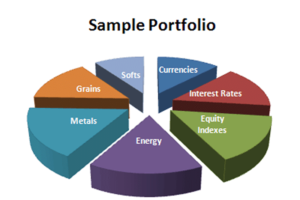Commodity Trading Advisors (CTAs) are professional investment managers, similar to portfolio managers in mutual funds, who seek to profit from movements in the global financial, commodity and currency markets by investing in exchange traded futures and options and OTC forward contracts.
The true value of the investment programs offered by CTAs is their portfolio construction approach, which allows investors to simultaneously participate in multiple global market sectors such as foreign exchange, energies, metals, interest rates, equity indices and commodities. Please see pie chart below.
Investments placed with a CTA are referred to as Managed Futures because the CTA can manage each client’s individual account, placing trades in the client’s account directly on their behalf, similar to a personal investment manager.
Are CTAs regulated?
Two of the main CTA regulatory bodies for the financial markets in the United States are: The Securities and Exchange Commission (SEC) and the Commodity Futures Trading Commission (CFTC). The SEC regulates equity and bond related securities and the CFTC regulates exchange traded futures and options products and foreign exchange.
Commodity Trading Advisors are required to be registered with the CFTC and become members of the National Futures Association (NFA).
Are all CTAs alike?
CTAs differ in their trading strategies, the markets they trade, experience level, and trading styles. Comparing a CTA that trades 65 markets worldwide against a CTA that specializes in global energy products is similar to comparing a large-cap mutual fund against a utilities-oriented fund. Therefore, it is important to understand the tools available to CTAs for extracting returns from the markets.
The biggest difference between Commodity Trading Advisors is the markets in which they trade. Some managers focus exclusively on a sector or group of markets (such as energy or grains), and others simultaneously trade up to 65 markets worldwide. The number of markets in which each CTA trades will have an effect on trading strategy and overall returns.

Trading Methodologies
Traditionally, CTAs have used a combination of technical and fundamental analysis to identify trading opportunities and implement their risk management strategies. Traders utilize multiple strategies in these forms of analysis, but generally find that traders tend to favor one over the over. Both forms of analysis work well for traders with expertise in a market sector or for those following a small number of markets. As a result, the key value driver for both technical and fundamental CTAs is their trading expertise in the markets in which they have developed a niche.
At the opposite end of the spectrum, many of the CTAs on our platform simultaneously trade over 40 markets worldwide. These CTAs utilize a systematic approach in building and managing portfolios of global futures contracts. Systematic traders utilize computer models to identify patterns such as trends on historical market and economic data. Trading and risk management decisions are made with respect to the portfolio as a whole.
Systematic trading for futures contracts allows for scalability and transparency. The value driver for these types of CTAs is their portfolio construction and risk management. Individual trades are not as important as the behavior of the portfolio as a whole.
Time Frames
CTAs not only differ in their trading strategies and markets traded, but also in the holding period focus of their trading systems. CTAs categorize their programs into short-term, intermediate term and long-term holding periods. Fund utilizing a short-term holding period strategy will hold trades for a period of seconds to three months before offsetting. On the other hand, CTAs using an intermediate-term or long-term strategy will hold trades for a period of three months to a year or for longer than one year, respectively. The specific holding period, or time frame that a CTA strategy employs plays a direct role in overall returns.
Emerging vs. Established CTAS
Another differentiating factor between Commodity Trading Advisors is whether they are emerging or established. There are various opinions of what defines emerging and what defines established. Emerging managers typically have less than a three-year track record and less than $50 million in assets under management. At first glance, it might seem that the only difference between an emerging and established CTA is their experience levels. However, there are many emerging CTAs that have a substantial amount of experience trading the markets and who have finally gone out on their own. Thus, while they might only have a few years experience trading on their own they are established traders in the industry and well-versed in its practices.
The major difference in distinguishing among emerging and established CTAs focuses on how they generate returns, as emerging CTAs can often outperform established managers. There are two main reasons for this. The first is that emerging CTAs are often smaller and more nimble, and are able to make transactions in certain markets that would be impossible for larger, more established CTAs. The second reason is that emerging CTAs are often eager (and more aggressive) to produce favorable return numbers that will allow them to pop on the radar screen of investors. An established billion dollar CTA might not have an extra incentive to be as aggressive.
There are, however, negative aspects to selecting an emerging CTA over an established CTA. While emerging CTAs may at times outperform their more established counterparts, the attrition rate is also higher. Many emerging CTAs often do not make it past their first year in business and some traders may not have any experience beyond trading for themselves.